|
Lawn diseases occur most often when lawn maintenance practices are not followed. Your best defense against disease is to follow proper cultural practices (see our Lawn Care Tips section for more information). Contact your local lawn care professional for proper diagnosis and treatment.
Southern Ontario
Turfgrass Disease Time Profile
| |
Jan |
Feb |
Mar |
Apr |
May |
Jun |
Jul |
Aug |
Sep |
Oct |
Nov |
Dec |
| Snow Mold |
 
  |
| Fusarium Patch |
   
    |
| Red Thread |
   
    |
| Smuts |
   
    |
| Leaf Spots |
 
  |
| Melting Out |
 
  |
| Dollar Spot |
 
  |
| Anthracnose |
 
  |
| Pythium Blight |
 
  |
| Rusts |
 
  |
| Ring Patch Disease |
 
  |
 Symptoms visible Symptoms visible  Periods of pathogen activity Periods of pathogen activity |
Anthracnose (Colletotrichum graminicola)
 Occurs particularly in spring through late summer, in heavy traffic and poorly drained areas. There will be irregularly shaped patches of yellowish-bronze areas ranging from 2” to several feet. Leaf lesions usually appear as elongated reddish-brown spots on leaves which may encompass the entire grass blade. Black fruiting bodies with tiny spines may also appear on foliage. Occurs particularly in spring through late summer, in heavy traffic and poorly drained areas. There will be irregularly shaped patches of yellowish-bronze areas ranging from 2” to several feet. Leaf lesions usually appear as elongated reddish-brown spots on leaves which may encompass the entire grass blade. Black fruiting bodies with tiny spines may also appear on foliage.
Control Options (Several cultural practices will help control diseases on lawns):
- Proper watering practices
- Increase your lawn mower height (3”)
- Avoid over watering your lawn
- Light applications of nitrogen

Dollar Spot (Sclerotinia homeocarpa)
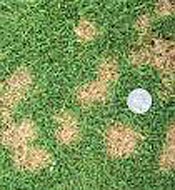 Occurs in summer, during warm weather. Round tan colored spots ranging from the size of a quarter to a silver dollar appear on the lawn. Spots appear sunken compared to the rest of your lawn. Yellow to light green lesions may appear and in the morning the spots appear grayish-white. Occurs in summer, during warm weather. Round tan colored spots ranging from the size of a quarter to a silver dollar appear on the lawn. Spots appear sunken compared to the rest of your lawn. Yellow to light green lesions may appear and in the morning the spots appear grayish-white.
Control Options (Several cultural practices will help control diseases on lawns):
- Dethatching or aeration may help
- Do not water at night
- Increase air circulation
- Increase your mower height to 3”
- Application of fertilizer may help

Fairy Ring (Basidiomycetes)
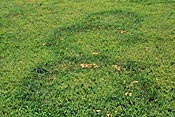 Occurs in early spring through late fall. Fairy Rings first appear as circles of dark green, lush, fast growing grass. A brown dead ring of grass surrounds the lush area. Several rings may appear in the same area. Rings or crescents commonly vary from 1 meter to 15 meters in diameter. Occurs in early spring through late fall. Fairy Rings first appear as circles of dark green, lush, fast growing grass. A brown dead ring of grass surrounds the lush area. Several rings may appear in the same area. Rings or crescents commonly vary from 1 meter to 15 meters in diameter.
They are caused by spores that become fungus that is contained within the soil and survives as mycelia or fungal roots. The mycelium can penetrate more than 30 cm (12”) into the soil. It attacks a central point in your lawn and grows outward.
Control Options (Several cultural practices will help control diseases on lawns):
- Remove lawn and soil in the infected area to a depth of 12” (this method is expensive, difficult and not always successful)
- Poke a garden fork into the rings and water heavily (supersaturate).
- Dethatching or aeration may help
- Overseed with a more disease resistant variety

Fusarium Patch (Microdochium nivale)
 Occurs in cool wet weather in the early spring and fall. The infected lower leaves first show small reddish-brown spots. These spots will grow up to 10” in diameter. White to pink mycelium may be seen on the outer area of the patch with the center area turning from white to brown as the grass dies. Fusarium patch infection in the fall may persist throughout the winter and may increase the risk of Pink Snow Mold in the spring. Occurs in cool wet weather in the early spring and fall. The infected lower leaves first show small reddish-brown spots. These spots will grow up to 10” in diameter. White to pink mycelium may be seen on the outer area of the patch with the center area turning from white to brown as the grass dies. Fusarium patch infection in the fall may persist throughout the winter and may increase the risk of Pink Snow Mold in the spring.
Control Options (Several cultural practices will help control diseases on lawns):
- Dethatching or aeration may help
- Increase air circulation
- Correct any drainage problems in your lawn
- Avoid applying high nitrogen fertilizer no later than 6 weeks before dormancy

Grey or Pink Snow Mold (Typhula incarnate or Fusarium nivale)
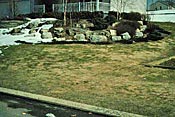 Snow Mould appears as a fluffy white, pink or grey residue that seems to follow the retreating snow line. Cool, wet conditions with or without snow cover cause this disease to flourish. Snow Mould appears as a fluffy white, pink or grey residue that seems to follow the retreating snow line. Cool, wet conditions with or without snow cover cause this disease to flourish.
A properly fertilized, well‑maintained lawn is most resistant to damage from snow mold. Raking in early spring through the snow mold residue will help reduce this disease and quicken the healing process.
Control Options (Several cultural practices will help control diseases on lawns):
- Dethatching or aeration may help
- Increase air circulation
- Increase sun exposure on infected areas
- Improve drainage
- Avoid applying high nitrogen fertilizer no later than 6 weeks before dormancy

Leaf Spot or Melting-out (Helminthosporium species)
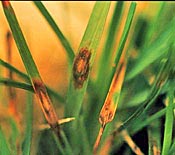 Occurs spring through summer during warm humid weather. Leaf spots are small dark purple to black spots on leaf blades. As the spots get larger the center turns a tan colour. As the temperature increases (above 28 C) the entire blade can appear dry and straw coloured. Leaf spots occur most often in lawns that are mowed too short. Occurs spring through summer during warm humid weather. Leaf spots are small dark purple to black spots on leaf blades. As the spots get larger the center turns a tan colour. As the temperature increases (above 28 C) the entire blade can appear dry and straw coloured. Leaf spots occur most often in lawns that are mowed too short.
Control Options (Several cultural practices will help control diseases on lawns):
- Increase your mower height (3”)
- Proper watering practices
- Dethatching or aeration may help
- Avoid high levels of nitrogen

Necrotic Ring Spot or Frog-eye (Leptosphaeria korrae)
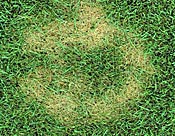 Occurs year round, especially in the spring but becomes more visible during warmer weather. It appears as perfectly shaped rings of yellowed‑out grass with healthy grass growing inside the ring. The disease can occur from year to year depending on environmental and cultural conditions. Occurs year round, especially in the spring but becomes more visible during warmer weather. It appears as perfectly shaped rings of yellowed‑out grass with healthy grass growing inside the ring. The disease can occur from year to year depending on environmental and cultural conditions.
Necrotic Ring Spot is a spore disease that is more common on sodded lawns but may also be found on seeded lawns in both sun and shade. The spores are spread by wind, air, water, animals and humans.
Control Options (Several cultural practices will help control diseases on lawns):
- Proper watering practices
- Avoid night time watering
- Increase mower height (3”)
- Overseed with perennial ryegrass

Powdery Mildew (Erysiphe graminis)
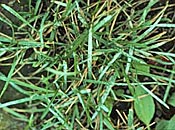 Occurs in late spring and fall. Areas of low light and poor air circulation favor the disease. Heavily shaded areas are particularly susceptible. Greyish-white powdery growth (looks like flour) appears on the blades. Starts as patches on the leaf blade and as the disease progresses it turns yellow and dies. Large areas infected with powdery mildew darken with age and sometimes transform into dark fruiting bodies. Infected plants are weakened, becoming more susceptible to other stresses. Occurs in late spring and fall. Areas of low light and poor air circulation favor the disease. Heavily shaded areas are particularly susceptible. Greyish-white powdery growth (looks like flour) appears on the blades. Starts as patches on the leaf blade and as the disease progresses it turns yellow and dies. Large areas infected with powdery mildew darken with age and sometimes transform into dark fruiting bodies. Infected plants are weakened, becoming more susceptible to other stresses.
Control Options (Several cultural practices will help control diseases on lawns):
- Increase mower height (3”)
- Improve air circulation
- Reduce shade areasor over seed with a shade tolerant seed
- Avoid over watering
- Aeration
- Avoid excessive nitrogen

Pythium (Pythium sp. Several)
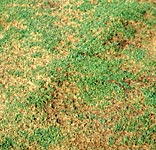 Occurs in the summer. Pythium is a fungal parasitic form of plant life. The fungi live in the soil thatch and dead leaves all year round and feed by drawing nutrients from the grass. During cooler parts of the season, they grow slowly and generally do not infect foliage. Some species cause roots to rot, during cool wet weather. When weather turns hot and humid, the fungi grow extremely rapidly causing infection and discoloration in a matter of hours. Outbreaks have been known to severely damage lawns in less then 24 hours. Occurs in the summer. Pythium is a fungal parasitic form of plant life. The fungi live in the soil thatch and dead leaves all year round and feed by drawing nutrients from the grass. During cooler parts of the season, they grow slowly and generally do not infect foliage. Some species cause roots to rot, during cool wet weather. When weather turns hot and humid, the fungi grow extremely rapidly causing infection and discoloration in a matter of hours. Outbreaks have been known to severely damage lawns in less then 24 hours.
Early symptoms include small dark spots about 2" in diameter with a slimy or greasy texture and these spots can increase rapidly in size. During damp periods, such as early morning, the water soaked leaves collapse and become matted together by a fluffy white mass called mycelium. As the grass dries, the mycelium disappears and dead blades turn brown. Damaged areas will often appear as long streaks due to the spread of spores and mycelium by mowing equipment.
Control Options (Several cultural practices will help control diseases on lawns):
- Correct any drainage problems in your lawn
- Avoid over watering
- Aeration may help
- Improve air circulation by thinning trees overhanging your lawn
- Use a balanced fertilizer program (do not over fertilize)

Red Thread (Laetisaria fuciformis)
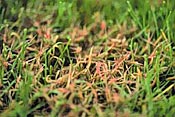 Occurs in cool, moist periods of spring and fall. It lives in soil, thatch and dead leaves all year round. Ragged patches of red to pink threads appear on the grass blade and sheath. Your lawn may appear from a distance to be suffering from lack of water. Red Thread looks like Leaf Spot and Dollar Spot. Occurs in cool, moist periods of spring and fall. It lives in soil, thatch and dead leaves all year round. Ragged patches of red to pink threads appear on the grass blade and sheath. Your lawn may appear from a distance to be suffering from lack of water. Red Thread looks like Leaf Spot and Dollar Spot.
Some factors which may encourage the spread of the disease are poor air circulation, poor drainage and a thick thatch layer. It spreads throughout the lawn in the form of spores. Wind, air, water, animals and humans spread these spores.
Red Thread attacks most types of grass but is generally found on lawns with low soil fertility that contains a high proportion of fescue and ryegrass.
Control Options (Several cultural practices will help control diseases on lawns):
- Increase air circulation
- Reduce shade areas
- Dethatching or aeration may help
- Proper watering
- Use a balanced fertilizer program (do not over fertilize)
- Maintain a soil pH of 6.5 – 7.0

Rusts (Puccinia species)
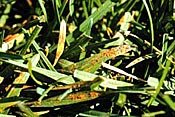 Occurs in late summer or fall affecting cool season grasses. Perennial Ryegrass is the most susceptible and Kentucky Bluegrass is less susceptible. Occurs in late summer or fall affecting cool season grasses. Perennial Ryegrass is the most susceptible and Kentucky Bluegrass is less susceptible.
Rusts is most active during temperatures of 22‑25C with a high humidity. Alternating weather patterns of cool and wet to hot and dry can also cause rusts. Rusts survive on the living and dead leaf tissue and in the thatch layer of turfgrass or on alternate hosts (ornamental plants).
Rusts appears as light yellow flecks on the leaves and sheaths, followed by reddish‑brown coloured spores. Rusts spores can be rubbed off easily, giving a reddish tinge to shoes and equipment. In most cases the rusts simply wilts the blades but in some extreme cases rusts can permanently damage your lawn.
Control Options (Several cultural practices will help control diseases on lawns):
- Increase mower height (3”) and frequency
- Proper watering practices
- Use a balanced fertilizer program
- Increase air circulation
- Overseed with disease resistant varieties

 Smuts (Ustilago species) Smuts (Ustilago species)
Occurs in spring and fall. Most turf grasses, particularly bluegrasses and bentgrasses are susceptible.
Cool conditions enhance fungal development and most of the infections occur in the spring and fall. Spring infections may have the greatest development and spore production before the summer and the infected plants may die in the hot dry weather. Fall infections may be less damaging in the same year but the fungus will over-winter and cause damage the following spring.
Smuts plants are pale green and stunted, with narrow long streaks that start off yellow and turn black. As the spores are released from the black stripes, the leaves look shredded and then die.
Control Options (Several cultural practices will help control diseases on lawns):
- Overseed with disease resistant varieties
- Use a balanced fertilizer program (do not over fertilize)
 |

